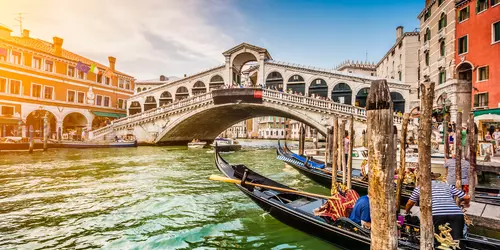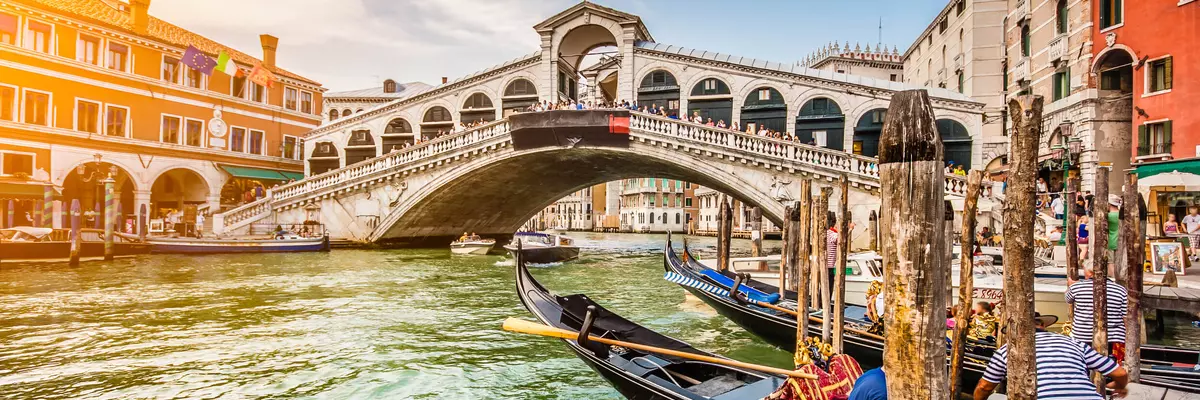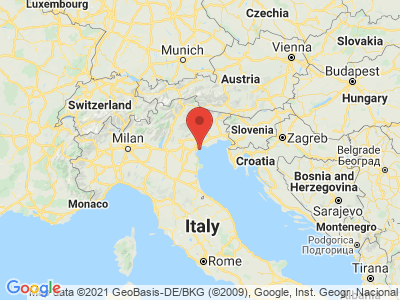Climate Table Venice
Jan | Feb | Mar | Apr | May | Jun | Jul | Aug | Sep | Oct | Nov | Dec | |
|---|---|---|---|---|---|---|---|---|---|---|---|---|
| Max. Temperature | 6° | 8° | 12° | 17° | 21° | 25° | 28° | 28° | 24° | 18° | 12° | 7° |
| Min. Temperature | 1° | 2° | 5° | 10° | 14° | 17° | 20° | 19° | 17° | 12° | 7° | 3° |
| Sun Hours | 3 | 4 | 5 | 6 | 8 | 8 | 10 | 8 | 7 | 5 | 2 | 3 |
| Water Temperature | 9° | 8° | 10° | 13° | 17° | 21° | 23° | 24° | 21° | 18° | 14° | 11° |
| Rain Days | 6 | 6 | 7 | 8 | 9 | 7 | 6 | 5 | 6 | 8 | 9 | 7 |
The climate year of Venice
Venice is famous for its bridges and waterways and also bears the name La Serenissima ("The Most Serene"), because until 1797 Venice was an important center of economy and politics for about 1000 years. The old city with its canals is located on 118 islands of the lagoon, to which are added the offshore long islands of Lido and Pellestrina, which separate Venice from the Adriatic Sea. In addition, the districts located on the mainland, Mestre, Marghera, Zelarino, Favaro Veneto and Chirignago are part of Venice. With its Mediterranean climate, the city has always attracted artists and tourists, and in 1987 was included by UNESCO on the list of World Heritage Sites. The lagoon is characterized by the maritime climate of the Adriatic Sea and the average daily maximum temperature in July and August is 27 °C. Rainfall starts in May and late summer and can quickly lead to high water, so the visitor should carry waterproof boots during this period.
General Venice
The Doge's Palace is one of the most visited buildings in Venice, right after the most famous square, St. Mark's Square, which is 175 meters long and up to 82 meters wide. During a sightseeing tour, the tourist is taken to the Doge's apartment, the government rooms and the armory. Since the 9th century, this was the seat of the Doge and the government of the Republic of Venice. The famous Bridge of Sighs leads across the Rio di Palazzo, an eight-meter-wide canal, from the Doge's Palace to the new prison (Prigioni nuove). Even more famous is the Rialto Bridge, which crosses the Grand Canal and has a length of 48 meters and a width of 22 meters. The passage of the gondolas is guaranteed with a clearance of 7.50 meters. A little away from the many tourists there is a beautiful park. Giardini Pubblici was created under Napoleon and invites today with palm trees, acacias and plane trees, statues and viewpoints on the lagoon, for a leisurely stroll.
Tourism Venice
The city of Venice is located in the temperate climate zone and the average annual temperature is 13.5°C, in July and August the average temperature is 22-23°C and in January 3°C. Temperatures rarely rise above 30°C in summer and the most rain falls in November with about 86 mm, the least rain falls in January with 53 mm. The differences between summer and winter are greater than in the more southern Mediterranean.


